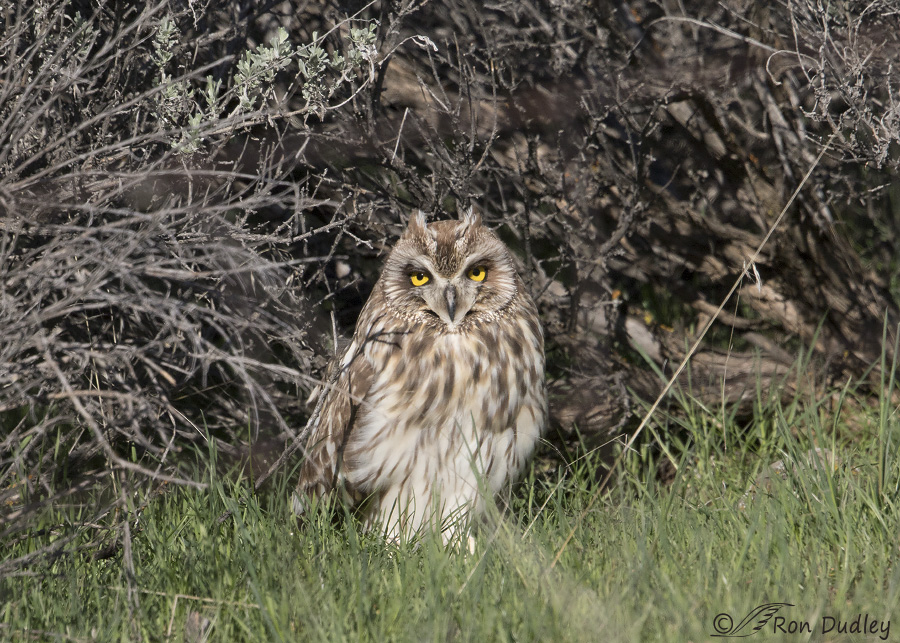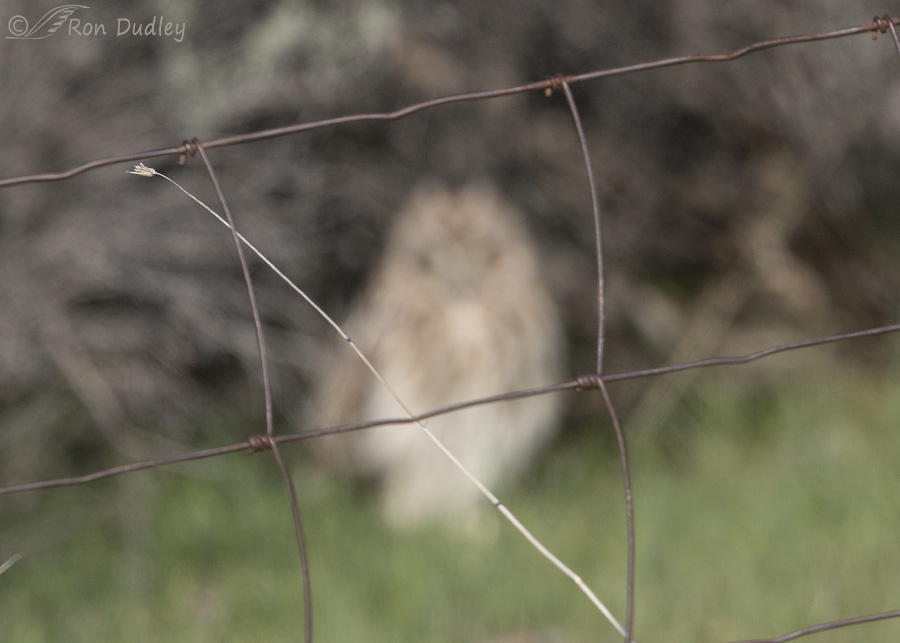As a bird photographer I sometimes find myself looking through my lens at an interesting bird with a wire fence between us. It happens more often than you might think. At times some of the wire can be directly in front of the bird and due to circumstances beyond my control I can’t move to a position that prevents the problem with the wire. Some photographers won’t even take the shot because of the obvious negative effects on the image of a visible wire.
But if you’re shooting with a long lens it can be worth taking the shot to see how it really turns out.
1/2000, f/7.1, ISO 500, Canon 7D Mark II, Canon EF 500mm f/4L IS II USM + EF 1.4 III Extender, not baited, set up or called in
I’ve seen a few Short-eared Owls on my last few trips to northern Utah but they’ve always been in flight and much too far away for decent photographs. But yesterday morning I photographed this bird along the road as it hunkered down in a spot well protected from the breeze to warm up in the sun. Temps were in the low 30’s so I’m sure that sun felt good. The bird barely budged in the few minutes I was with it – in fact about the only movement I noticed was when it would slowly close and open its eyes. This isn’t a great image but it’s my first SEO of the year and I was happy to get it but it was mostly just a delight to get a good look at the species again. I’ve missed them very much.
There’s actually lots of fence wire between me and the owl but can you see any of it? I cannot. I can see an out of focus, light colored stem running diagonally across the belly of the bird and into the darker background but I can’t see any wire.
1/2000, f/7.1, ISO 500, Canon 7D Mark II, Canon EF 500mm f/4L IS II USM + EF 1.4 III Extender, not baited, set up or called in
Here’s another photo of the same owl from the same vantage point. For this shot I deliberately tried to focus on the wire but it was so thin I had difficulty locking onto it so instead I focused on a fencepost out of frame to the right and then recomposed with the owl in the center. That got the wire much sharper so it can be seen easily but it’s still quite soft because the post was slightly further away than the wire in front of the bird.
So why did the wire mostly or completely disappear in the first image?
Images taken at long focal lengths have very little depth of field. According to this depth of field calculator my DOF at this focal length (1120mm effectively), this distance from the subject (estimated at 60′) and this aperture (f/7.1) would only be .82 ft or 9.84 inches. The further an object is in front of the bird or behind it the more out of focus it becomes, eventually to the point that something as thin as this wire would be undetectable or very nearly so. The diagonal piece of vegetation behind the wire can be seen a little more easily because of its greater contrast with the darker background and because it’s a little closer to my focusing distance so it’s sharper than the wire (especially at the top).
According to the calculator if I’d been using my 100-400mm zoom lens @ 100mm and at the same aperture my DOF would have been 31.46 ft! In that situation the wire would have been about as sharp and visible as the bird (though of course the owl would have been very small in the frame). If you’re an experienced photographer this likely won’t be any news to you but even advanced amateurs often pass up an opportunity like this because they instinctively assume the wire will ruin the image.
But at long focal lengths that isn’t always the case. Take the shot – pixels are cheap.
Ron




I see owl. No wire. I sigh with admiration (and a smidge of envy).
And I am grateful for the continuing education as well. As always, megathanks.
Thank you, EC.
Very useful post, Ron. First of all, super sweet pic. I have a special out-of-this-world feeling whenever I see owls (except burrowing owls who live on ground anyways, but I’m still thrilled to see them as well) on ground. As for the DoF, lately I’ve been struggling a lot, on two things. 1. In low light situation, sometimes I can just use f/4, and if I focus on the snout of an animal, their eyes will not be critically sharp, such as bobcats. Or even owls, if the focus point was by accident on the bill, the eyes r not critically sharp. These days I use center focus point with 4 surrounding in flights, so those surrounding points always screw me up when i do close portrait because they will catch on the bill even when i have center point on the eye, but i was waiting for flight shot and sometimes u can’t switch quick enough. 2. when in flight, how much f stop to get the head in focus if by accident i focus on the body of the bird. I struggled a lot with burrowing owl in flight last year, at the end I have to sacrifice speed to have f/8 to get critically sharp eyes. Well I guess I answered my own questions here. It’s useful to know the distance from the animal, the f-stop depth, and how far the bill or snout of the bird or animal is from their eyes.
Thank you, Tin. You’ve struggled with some of the same things I have!
Super image — horns up and partially closed eyes. Looks like a monarch surveying his kingdom. Thanks for the optics lesson too.
Thanks, Marty. As far as I’m concerned he/she IS a monarch! (I feel that way because it’s been so long since I’ve photographed one…)
A beautiful owl! And I still can’t see any hints of wire even though you’ve told us it’s there! Looking forward to seeing more of these guys (as I’m sure you are). Thanks, Ron.
I couldn’t see them either, Chris. Even when Ed (below) described where he could (barely) see a couple of them I had a hard time spotting even one of those wires…
Great photo and lesson.
Thanks, Susan.
Great discussion and example of depth of field Ron. I cannot see any wire in front of the owl, and that is the most important part. I can see a faint blur of the top wire running diagonally above the owl, and a tiny bit of the lower wire on the sides of it, however I would not have noticed these if I was not aware of the wire and had intentionally looked for them.
You are correct about about the shallow depth of field for the long focal length. The depth of field is also a strong function of how close the subject is to you. So if the owl is very close, and you focus on the owl, the DOF can be minuscule, relative to an owl (subject) at further distances. I really noticed this the past few weeks photographing Sandhill Cranes doing their courtship dance up close.
That is great you were able to see the Short-eared owls. You have some of the very best images I have ever seen of them Ron! I look forward to seeing your photographs this spring.
Ed. It’s nice to know that you, with your knowledge of optics, can confirm my points on a subject that I’m far from an authority on. Thanks for that!
And thank you for the fine compliment on my SEO images!
“Take the shot – pixels are cheap.” Good advice Ron, that is what I go by!
My only problem with it is culling all those shots I take. Not really complaining, just saying!
Love the owl, that long focal length makes a big difference.
Dick, Can you imagine having to pay the prices we used to pay for film and printing? And waiting that long to get our results? There are at least a few things that are better today than they were back in the “good old days”…
Ah yes, the good old days! Went to Africa in 89′ took over 70 rolls of 36 pictures each of Kodochrome and Ectochrome film and waited forever and paid all out for those rolls to be developed.
What a huge huge advantage it is today, I certainly will agree with that!!
I already knew today’s subject but it is always a pleasure to see the way you explain those things.
I wish I have had a bunch of teachers like you back in my school days. Everything would have been easier.
Thanks for the photo. Beautiful bird.
Those very kind words are much appreciated, Jorge!
Nice to see the SEO’s reappearing in Northern Utah. I look forward to visiting them soon.
Neil, I actually thought of you while we were on that owl…
Another great photo… I love owls… and a very useful lesson for those new to “wildlife photography.”
I told Mia today that the great number of hawks, and owls that the two of you find makes me sooo
jealous, combined with the fact that you get close enough to them to get great images. You two
keep me inspired, and learning with your images, and informative narratives… Thanks. ;-)))
Thanks very much, Roger. As you’ve noticed we work very hard at getting decent raptor shots.
Pixel’s ARE cheap! 🙂 I’ve noticed fence wire becoming almost invisible a few times and, seems I remember folks at zoos using that technique to make the bars disappear. NICE photo of the SEO – they certainly look different with “horns” up and fluffed up a bit!
Judy, this one had its “horns” up the entire time I was with it and I couldn’t figure out why. It was very relaxed – to the point that it almost fell asleep.